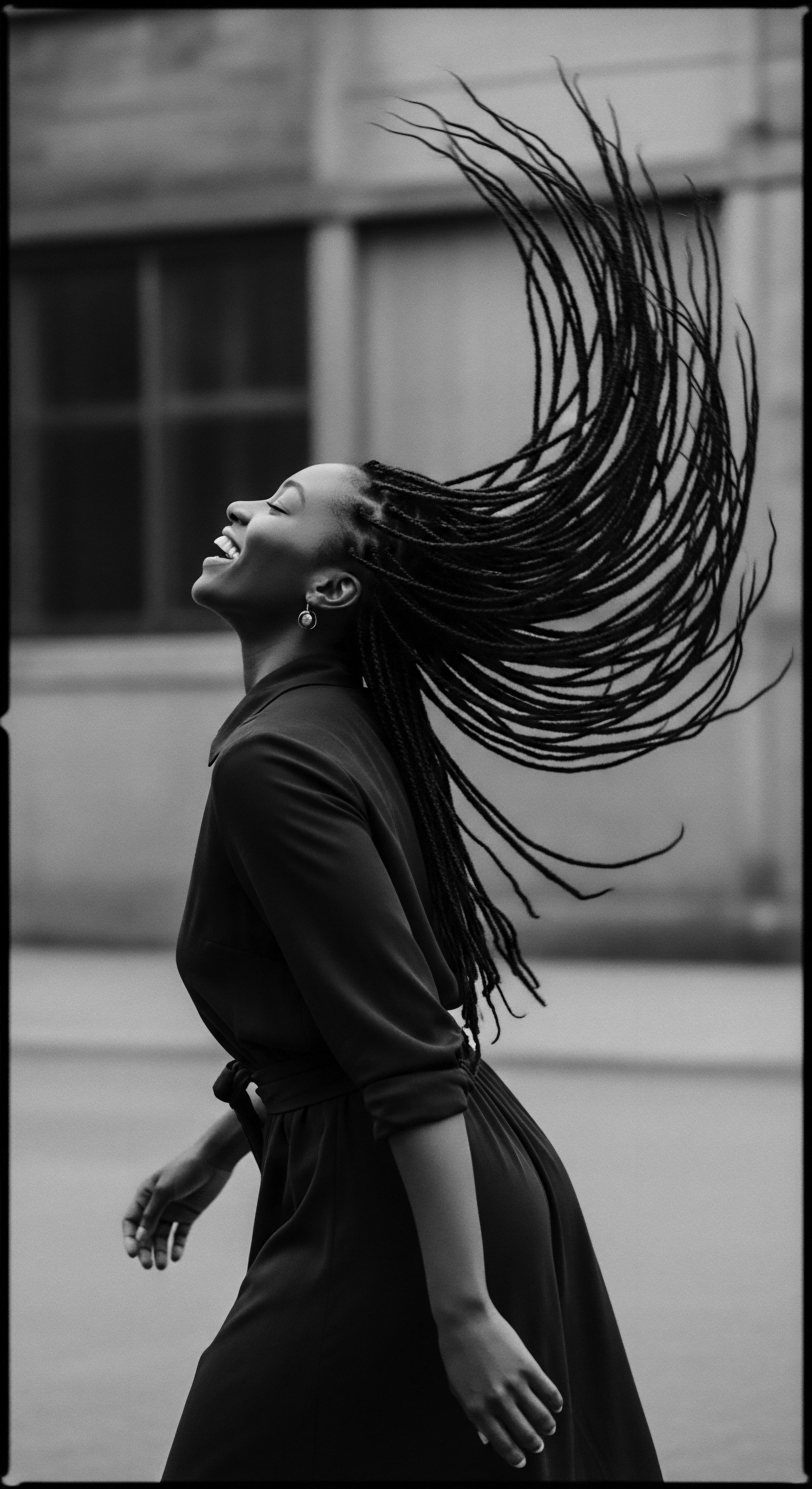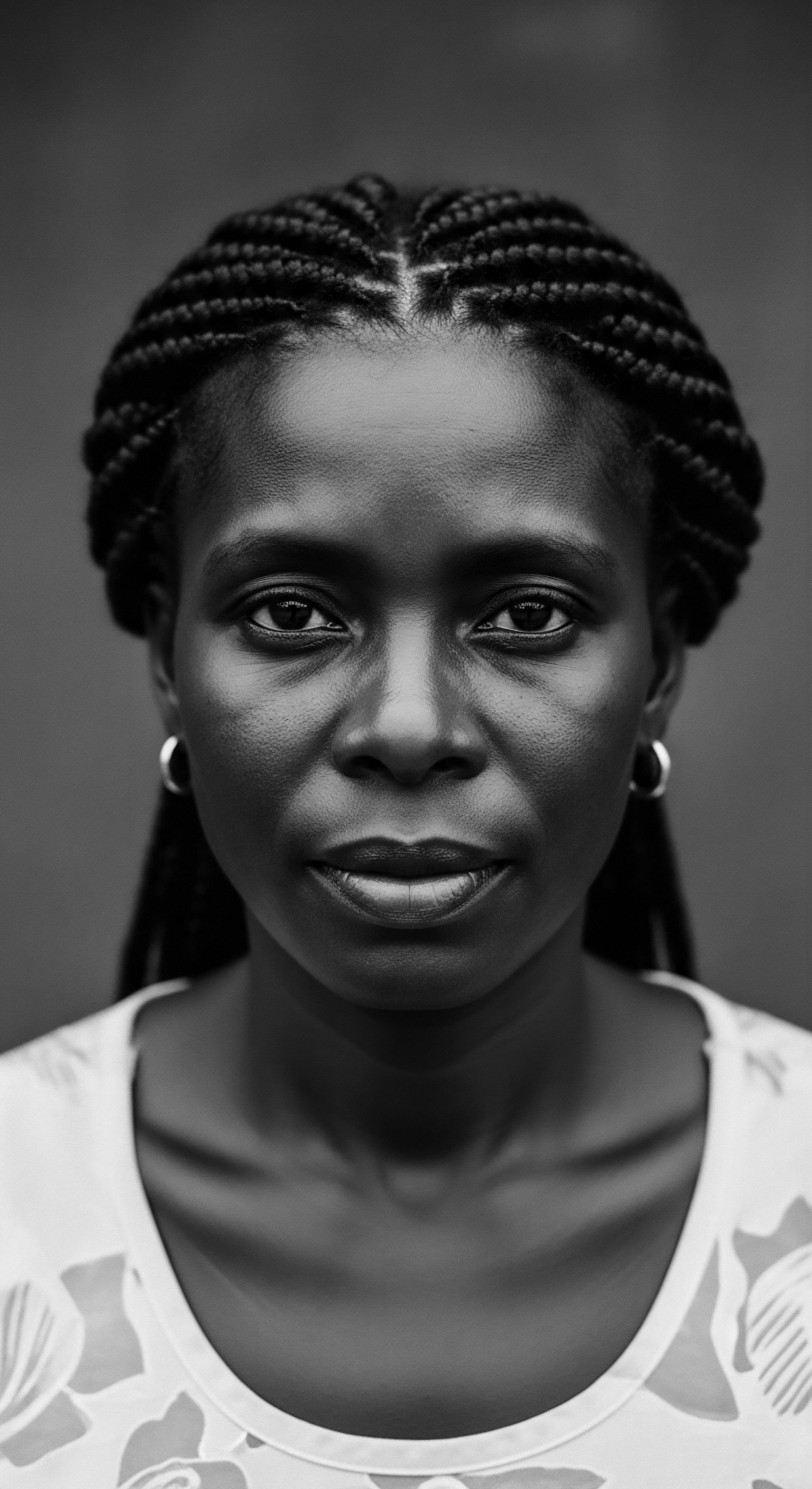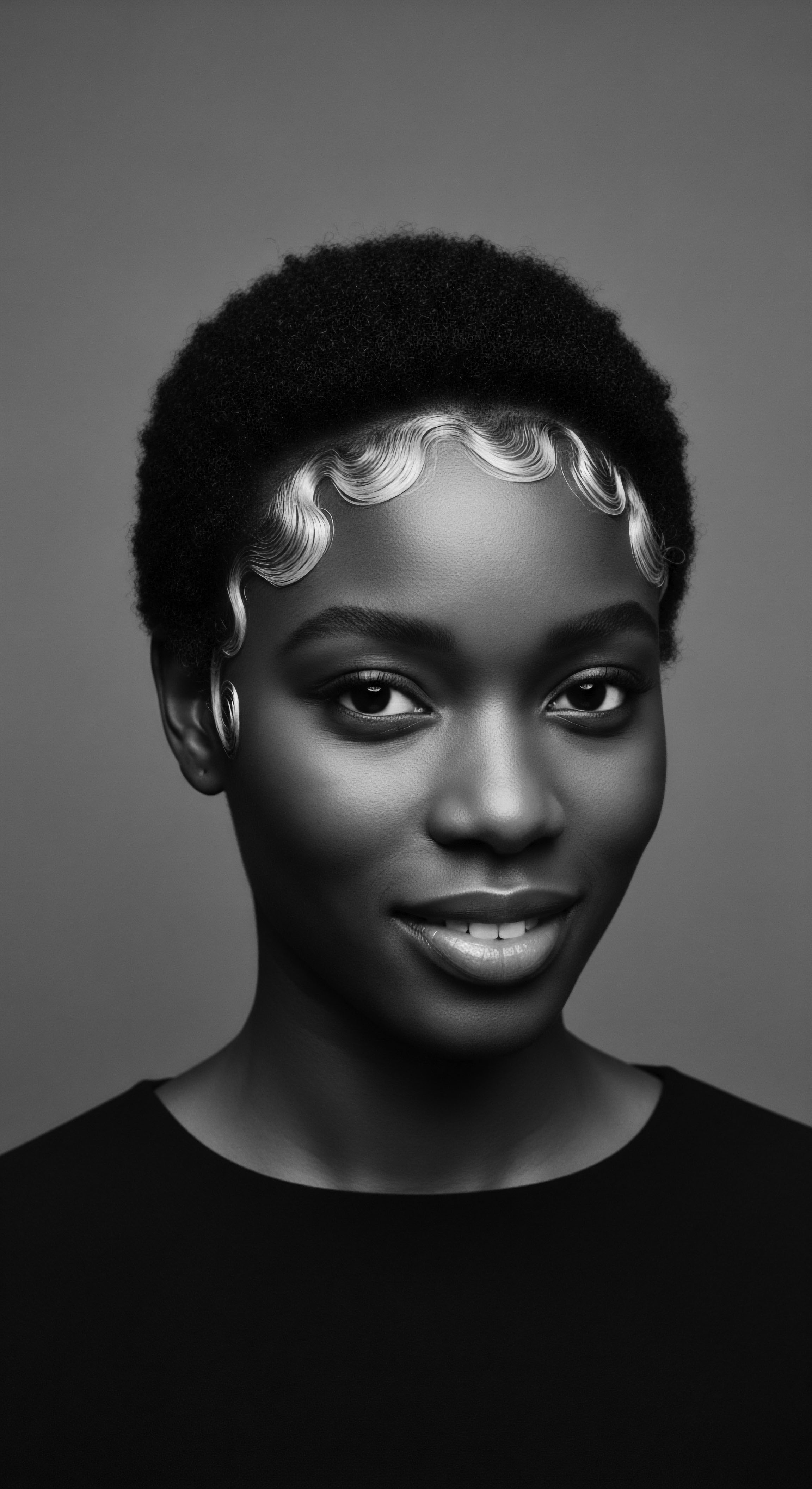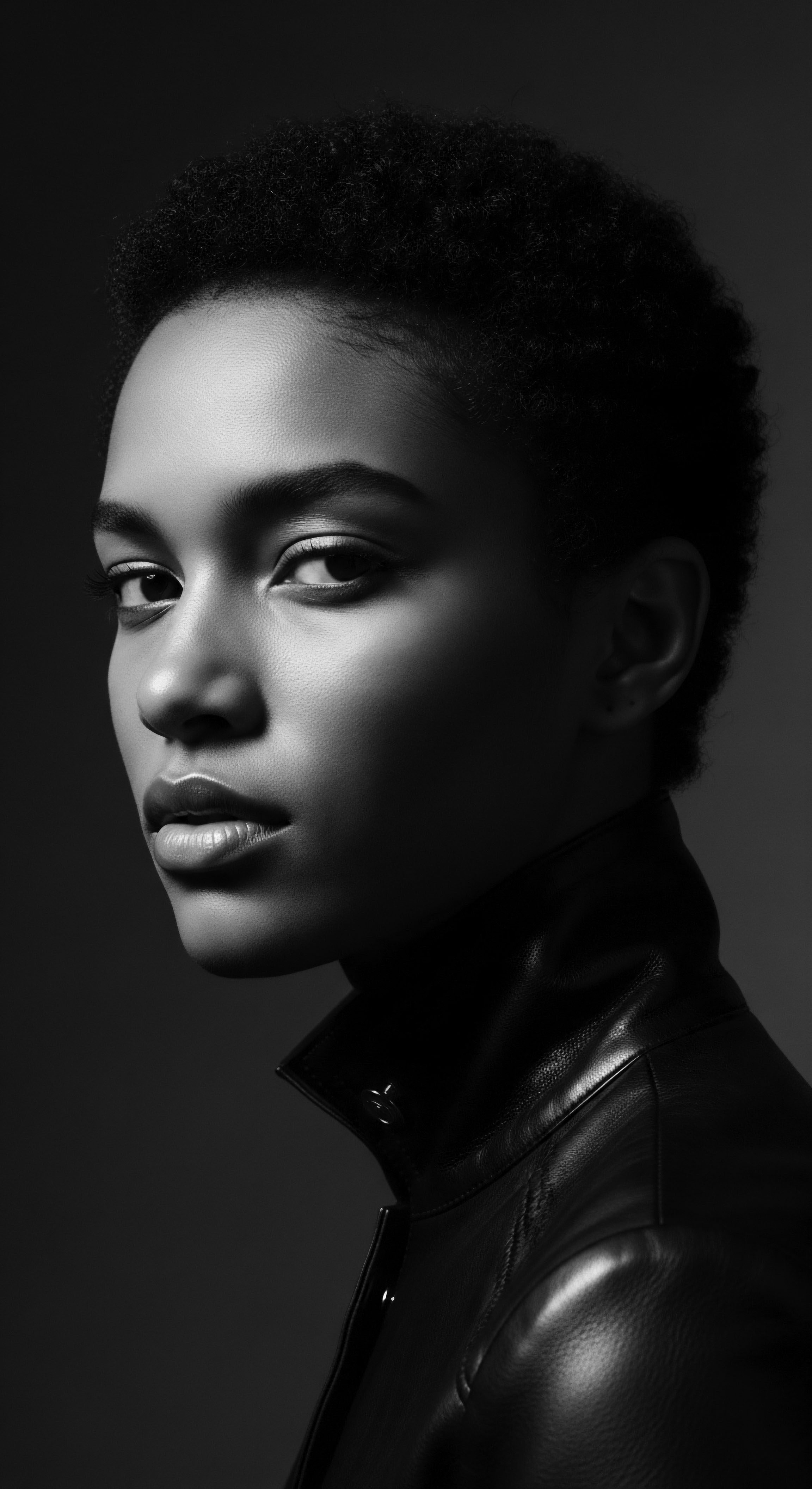
Roots
Consider for a moment the very essence of a strand, its curl, its coil, its unique trajectory emerging from the scalp. For generations beyond memory, the early comprehension of this remarkable fiber was not penned in scientific journals or debated in academic halls. Instead, it was etched into the communal spirit, woven through daily rhythms, and understood through an intimate connection with the living world.
The ancestral lens, indeed, provided the primary view of textured hair, seeing it not as a mere adornment but as a vibrant extension of self, community, and the cosmic order. This deeply rooted perspective, steeped in a profound reverence for heritage, shaped every interaction with the hair, from its genesis to its intricate styling.

What Were Early Conceptualizations of Hair Anatomy?
Long before microscopes unveiled the minute architecture of the hair shaft, ancestral communities understood its fundamental properties through observation and intuitive knowledge. They recognized the diverse forms of textured hair, from the tightly coiled helix to more loosely defined waves, and understood that these variations demanded distinct approaches to care. The resilience, the elasticity, the inherent strength of textured strands were not abstract concepts; they were felt through the fingers, observed in the sun’s reflection, and honored in ritual. This discernment was often tied to the very environment—the arid winds of the Sahara, the humid air of the rainforest, the ocean spray of coastal villages—which undoubtedly influenced the practical care regimens that sprung forth.
Ancestral communities viewed textured hair not as a simple adornment, but as a living extension of self, community, and cosmic order, influencing every aspect of its care and perception.
In many West African societies, for example, the hair was perceived as a conduit between the spiritual and physical realms. The very crown of the head, where hair originates, was deemed sacred, a point of connection to the divine. This belief underpinned the careful handling of hair, where combs were not just tools, but sacred implements, and the act of hair dressing became a ritualistic exchange of energy and wisdom. The understanding of hair’s anatomy, in this context, extended beyond its physical composition to its spiritual and energetic properties, underscoring a holistic view that modern science is only beginning to reconnect with.

How Did Ancient Societies Classify Hair Textures?
While formal classification systems similar to modern typing charts did not exist, ancient societies possessed nuanced ways of categorizing hair textures, often linking them to lineage, social standing, and geographical origin. The terms used were less about numerical scales and more about descriptive qualities that resonated with communal understanding. For instance, in some parts of ancient Kemet, certain hairstyles and hair treatments were reserved for specific social classes or priestly castes, implying an inherent recognition of different hair types that could hold these styles.
- Coil Patterns ❉ Descriptions of tightly wound or spring-like curls, often associated with a vibrancy of spirit or connection to specific ancestral lines.
- Strand Thickness ❉ Observations of fine versus coarse hair, guiding choices in botanical oils and styling techniques to prevent breakage or promote retention.
- Density ❉ An understanding of the fullness of the hair, influencing communal grooming practices and the sharing of growth secrets passed down through generations.
This qualitative assessment of hair texture was deeply embedded within cultural practices. The way hair behaved—its response to moisture, its ability to hold a braid, its natural shrinkage—dictated the traditional care methods and styling possibilities. These observations formed a lexicon of textured hair knowledge, passed from elder to youth, shaping the foundational views of what was possible, healthy, and beautiful for each hair type.

What Traditional Terms Described Textured Hair?
The language of textured hair in ancestral contexts was rich with descriptive terms that were not merely functional but also conveyed a reverence for its diverse forms. There were words that mimicked the movement of water, the patterns of nature, or the resilience of resilient fibers. These terms often intertwined with the names of specific hairstyles, tools, or ingredients, creating a holistic vocabulary.
For instance, in various African languages, specific words describe the tight curl of particular hair types, differentiating them from looser curls or waves, each carrying its own cultural connotation and prescribed care. The linguistic precision demonstrates a deep observational heritage.
| Ancestral Observation Hair as a spiritual antenna |
| Contemporary Scientific Correlate The highly conductive nature of melanin in hair, and hair's electrophysiological properties. |
| Ancestral Observation Resilience against elements |
| Contemporary Scientific Correlate The hair follicle's adaptability to environmental stressors and genetic predispositions for durability. |
| Ancestral Observation Varying degrees of curl |
| Contemporary Scientific Correlate Different cortical cell arrangements (orthocortex and paracortex) and follicle shape that dictate curl pattern. |
| Ancestral Observation The deep ancestral understanding of hair properties often finds surprising correlations with current scientific discoveries, linking heritage to contemporary insight. |
The very names given to traditional hair implements or styling methods spoke to the characteristics of the hair they served. A comb designed for detangling tightly coiled hair would have a name reflecting its strength or its ability to gently separate. An oil prepared for shine might be named after a glistening river. This linguistic tapestry reveals how ancestral practices were not accidental but informed by keen observation and a profound understanding of textured hair’s inherent nature.

Ritual
From the foundational understanding gleaned through generations, the daily interaction with textured hair transcended mere grooming. It became a ritual, a sacred practice interwoven with community life, personal identity, and the passing of ancestral wisdom. The techniques, the tools, the very transformative power of styling textured hair—all were deeply influenced by these long-standing practices, which sought to honor and maintain the hair’s unique qualities. This dedication to purposeful action, born of ancient knowledge, shaped the early views of textured hair as something to be tended with care, artistry, and communal reverence.

What Ancestral Roots Do Protective Styles Have?
Protective styles, a cornerstone of textured hair care today, possess a rich and storied ancestry. For centuries, across various African societies, braiding, twisting, and coiling served multiple purposes beyond aesthetic appeal. They preserved the hair from harsh elements, minimized breakage, and promoted growth by reducing manipulation.
These styles were often codified, with specific patterns indicating marital status, age, tribal affiliation, or even one’s spiritual journey. The art of creating these styles was a skill passed down, often from mother to daughter, elder to apprentice, a tangible link to heritage.
Protective styles, ancient and enduring, safeguarded textured hair while serving as a visual language of identity, status, and communal connection across generations.
Consider the intricate cornrows of ancient Ethiopia or the elaborate braided patterns of the Fulani people. These were not random creations; each line, each curve held meaning, a visual narrative told through the hair. The view of textured hair, therefore, was intrinsically tied to its potential for storytelling and its ability to act as a living canvas for cultural expression.
The very act of styling was communal, a time for sharing stories, wisdom, and laughter, solidifying bonds and reinforcing the collective understanding of hair’s place in society. The early views, therefore, saw hair as a vibrant marker, a map of one’s journey and belonging.

How Were Natural Styles Historically Defined?
Before the advent of chemical relaxers and widespread heat styling, natural textured hair in its diverse forms was the norm. Ancestral practices developed specific methods to define and enhance the hair’s inherent curl, coil, or wave pattern using natural ingredients and gentle manipulation. Oils, butters, and infusions from various plants were regularly applied to add moisture, softness, and shine, allowing the hair to settle into its natural structure. The aim was often not to alter the hair’s fundamental nature, but to celebrate and maintain its organic beauty.
For instance, the use of shea butter across West Africa or various plant-based gels in other regions provided slip for detangling and created soft definition. The emphasis was on working with the hair, not against it. This approach fostered an early view of textured hair as inherently beautiful and capable of holding its own unique shape, needing only nourishment and gentle encouragement. The communal validation of natural textures played a significant role in cementing this positive perception within the collective consciousness, a heritage of self-acceptance that persisted through time.

What Historical Role Did Wigs and Extensions Play?
Wigs and hair extensions, far from being modern inventions, possess a rich historical lineage, particularly in African heritage. In ancient Kemet, for example, elaborate wigs made from human hair, plant fibers, and even wool were symbols of status, hygiene, and ritual significance. They protected the scalp from the sun, allowed for complex, often symbolic, styling that real hair might not achieve, and could be easily cleaned. These wigs were carefully crafted, often styled into braids, coils, and intricate patterns that mimicked and enhanced natural textured hair.
- Social Status Markers ❉ Wigs indicated wealth, position, and power, with their size and ornamentation often correlating to an individual’s standing within society.
- Ritual and Ceremony ❉ Special wigs were created for religious ceremonies, funerals, or royal events, imbued with symbolic meaning and serving as ritual adornments.
- Protection and Hygiene ❉ Wigs shielded the natural hair and scalp from environmental elements, making it easier to maintain cleanliness, especially in hot climates.
This historical use established a view of hair augmentation as a tool for expression, status, and practical necessity, not as a disguise or a sign of inadequacy. The ability to transform one’s appearance through skillfully crafted hairpieces was a form of artistry, reflecting a deep respect for both the natural hair underneath and the creative possibilities of adornment. The artistry in creating wigs, mimicking the various textures and styles of natural hair, solidified the view of hair as a malleable and significant aspect of identity.

Relay
The enduring legacy of ancestral practices continues to echo through contemporary hair care, providing a powerful relay of wisdom from past to present. The early views of textured hair, shaped by intimate knowledge of plants, communal support, and spiritual reverence, directly inform our understanding of holistic care and problem-solving today. This profound connection to heritage grounds modern approaches, revealing how ancient ingenuity offers both validation and fresh perspectives on nurturing textured hair for its optimal health and vibrancy.

How Did Ancestral Wisdom Shape Hair Regimens?
Ancestral communities did not merely “do” hair; they engaged in comprehensive regimens, deeply integrated into their daily lives and seasonal cycles. These regimens were dynamic, adapting to the environment, available resources, and individual needs. The sequential steps of cleansing, oiling, moisturizing, and styling were not arbitrary; they were refined over millennia, driven by observable results and passed down as essential knowledge. This laid the groundwork for our contemporary understanding of multi-step hair care.
For example, the consistent use of saponins from plants for gentle cleansing, followed by the application of rich seed butters and oils like baobab or moringa, established a clear pattern of nourishment. These practices were intrinsically tied to the local flora and fauna, demonstrating an ecological awareness long before the term existed. The early view of textured hair, therefore, was one that recognized its dependency on nature’s bounty and the necessity of a sustained, attentive approach to its wellbeing. The understanding that prevention through regular, gentle care was superior to reactive treatment was a cornerstone of these ancestral regimens, a wisdom that we now quantify with scientific data.

What Was the Historical Basis for Nighttime Protection?
The practice of protecting hair at night, now commonly associated with bonnets and silk scarves, also finds its genesis in ancestral foresight. While direct archaeological evidence of ancient bonnets might be scarce, historical accounts and cultural practices suggest various forms of head coverings were used for preservation. In numerous African societies, head wraps were a ubiquitous part of daily attire, often serving as both a fashion statement and a practical measure. At night, these wraps or simpler fabric coverings would have shielded delicate hairstyles and prevented friction, especially for intricate braids or straightened strands, ensuring their longevity.
The early views of textured hair understood its vulnerability to tangling and moisture loss during sleep. By using protective coverings, communities intuitively guarded against damage, thereby contributing to hair length retention and health. This thoughtful nightly ritual, whether through simple cloth or intricately tied head coverings, became a fundamental component of holistic hair care, signifying a deep reverence for the hair’s delicate nature and the effort invested in its styling. It speaks to a cultural understanding that hair health was a continuous, round-the-clock endeavor.
| Ancestral Ingredient/Practice Shea Butter (Vitellaria paradoxa) |
| Benefits Observed/Modern Equivalent Emollient, rich in fatty acids (oleic, stearic), provides moisture, reduces breakage. |
| Ancestral Ingredient/Practice Moringa Oil (Moringa oleifera) |
| Benefits Observed/Modern Equivalent Lightweight oil, high in antioxidants and vitamins A & E, promotes shine and scalp health. |
| Ancestral Ingredient/Practice Hibiscus (Hibiscus sabdariffa) |
| Benefits Observed/Modern Equivalent Mucilage content for detangling, provides mild cleansing, conditions hair strands. |
| Ancestral Ingredient/Practice The efficacy of ancestral hair care ingredients is frequently supported by modern phytochemical analysis, validating centuries of empirical observation and heritage. |

How Did Communities Address Hair Concerns Ancestrally?
The concept of “problem-solving” for textured hair, from dryness to shedding, was addressed through a profound understanding of herbal medicine, nutrition, and environmental factors. Traditional healers and hair specialists within communities possessed encyclopedic knowledge of local botanicals and their therapeutic properties. They knew which roots, leaves, barks, or seeds could alleviate scalp irritation, stimulate growth, or restore moisture balance. This empirical knowledge, honed over countless generations, formed the bedrock of ancestral hair care.
For example, in certain West African cultures, the baobab tree was not only a source of fruit but also its oil and leaves were used for hair nourishment and strength. Its oil, replete with omega fatty acids and vitamins, was a prized elixir for dry, brittle strands. The application of this oil, coupled with specific massage techniques, aimed to address common hair challenges holistically. This suggests an early view of hair health as an integral part of overall bodily wellness, where external care mirrored internal vitality.
A compelling example of ancestral understanding of hair concerns can be seen in the practices of the Himba people of Namibia. Their renowned “Otjize” mixture, a paste of butterfat, ochre, and aromatic resin, serves multiple purposes. It offers sun protection, acts as an insect repellent, and contributes to the distinct red hue of their skin and hair. Beyond aesthetics, the butterfat deeply conditions their intricately braided hair, preventing dryness and breakage in the arid climate, while the ochre acts as a natural sunblock.
This tradition, passed down through matriarchal lines, demonstrates a sophisticated, multi-purpose solution to hair care challenges rooted in environmental adaptation and centuries of empirical observation (Crone & Visser, 2017). This practice, refined over generations, profoundly shaped the Himba’s communal view of hair ❉ a living part of their identity, a symbol of their land, and a canvas for their resilient beauty, all maintained through ancestral knowledge and readily available natural resources.
Ancestral communities addressed hair concerns through a deep ecological knowledge, utilizing local botanicals and holistic wellness practices for centuries.
Furthermore, dietary habits and communal well-being were understood to directly impact hair condition. Foods rich in fats, proteins, and micronutrients were revered, and their link to healthy hair and skin was not lost on these communities. When hair appeared dull or weak, the initial inquiry might extend to one’s diet or even stress levels within the community.
This integrated approach reflects a powerful, early view ❉ that hair is a mirror reflecting internal health and external conditions, necessitating a comprehensive, heritage-informed strategy for its care. The relay of this wisdom through oral tradition and lived practice ensures that these profound connections persist, even as modern science quantifies their mechanisms.

Reflection
The journey through the ancestral practices that shaped early views of textured hair is, at its heart, a profound meditation on heritage itself. We walk through echoes of ancient wisdom, witnessing how hair was not merely seen but felt, understood, and honored as a living archive of identity and connection. From the intuitive grasp of hair’s very structure to the communal rituals of styling and the ingenious solutions for its care, each practice speaks volumes about the reverence held for textured strands across time and diverse cultures. This collective understanding, transmitted from elder to youth, forms a continuous, vibrant thread that binds the past to the present.
The ‘Soul of a Strand,’ then, truly embodies this enduring legacy—a recognition that within each curl and coil resides not just elemental biology, but a rich lineage of human ingenuity, spiritual belief, and an unbreakable testament to resilience. As we look ahead, the whispers of these ancestral voices continue to guide us, inviting us to approach our textured hair not with questions of deficiency, but with a deep, abiding appreciation for its innate strength and beauty, a gift passed down through the ages.

References
- Crone, W. C. & Visser, C. (2017). The Science of the Hair ❉ From Molecules to Hair Care Products. Elsevier.
- Byrd, A. D. & Tharps, L. D. (2014). Hair Story ❉ Untangling the Roots of Black Hair in America. St. Martin’s Press.
- Mercer, K. (1994). Welcome to the Jungle ❉ New Positions in Black Cultural Studies. Routledge.
- Bankole, K. (2011). African Americans and the Attire of Their Hair ❉ The Politics of Hair and the Performance of Black Culture. Palgrave Macmillan.
- Ross, R. A. (2009). Black Heritage Sites ❉ An African American Cultural Reference Guide. Wiley.
- Akbar, A. M. (2015). African Hair ❉ Culture, Beauty, and Practices. Xlibris Corporation.
- Okoro, N. (2007). African Hair and the Politics of Identity. Africa World Press.
